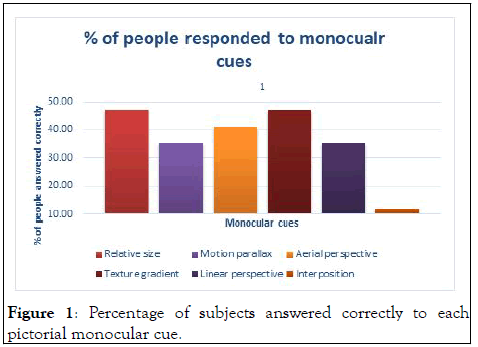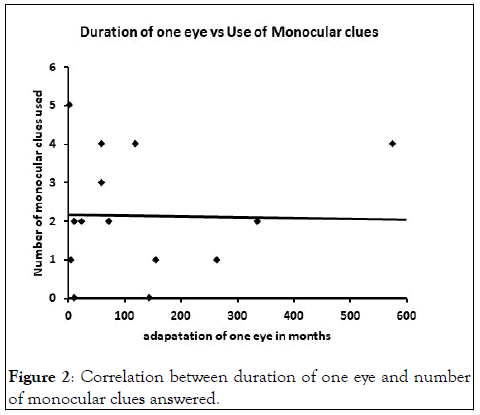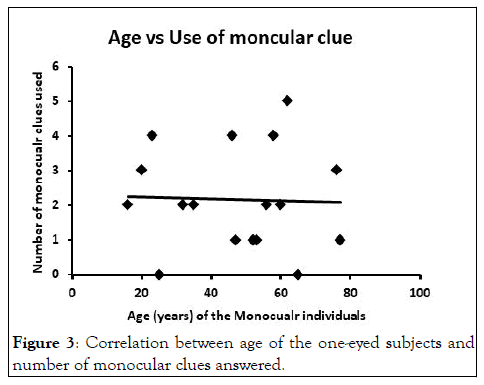Journal of Clinical and Experimental Ophthalmology
Open Access
ISSN: 2155-9570
ISSN: 2155-9570
Research Article - (2023)Volume 14, Issue 3
Aim: The main aim of the study is to find out whether one-eyed patients use all pictorial monocular cues successfully in their day to day activities.
Methods: A pilot study was conducted on seventeen one-eyed subjects with a mean age of 47.23 yrs. ± 19.10 yrs. Subjects were given a forced choice questionnaire that consists of questions that would evaluate the use of all pictorial monocular cues in day to day activities. Each question has one right answer that is randomized and would fit with the use of the pictorial monocular cue. We determined whether a subject chooses the right answer for each question. Based on the answers we determined the number of pictorial monocular cues used by each subject.
Results: Results show that none of the subjects use all the monocular cues and two subjects did not even use one pictorial monocular cue. One-eyed patients commonly used pictorial monocular cues are relative size and texture gradient (47%), followed by aerial perspective (41%), motion parallax (35%) and linear perspective (35%). The least used monocular cue is interposition (12%). We also noted adaptation period and age (above 18 years) have no effect on the use of monocular cues.
Conclusion: Most one-eyed subjects are not aware of the existence of monocular cues that can be used to perform their day today activities successfully which will emphasize the fact that these patients needs counseling on awareness and use of the monocular cues to perform better in their routine day to day tasks.
Monocular; Binocular; Pictorial cues; Depth perception; Peripheral field
Monocular vision differs from binocular vision in the main aspect which we call two-dimensional and three-dimensional viewing. Monocular subjects have an absence of stereopsis due to the lack of retinal disparity between both eyes that is present in binocular subjects. Monocular individuals (compared to their binocular counterparts) will have decreased visual acuity because of their lack of binocular summation. According to Von Noorden, binocular individuals have advantages over monocular individuals in terms of visual motor skills, exteroception of form and colour, and well appreciation of the relation between body and surroundings and these factors facilitate good manipulation, reaching and balance of the objects. Individuals who acquired monocularity due to disease or trauma have a significant effect in their visual performance in several ways [1].
From past studies, the two primary deficits that were noted in monocular subjects were loss of stereopsis and reduction in the visual field in the periphery. Studies have shown that people with monocular vision approximately lose 20%-25% of their field of view in comparison to people with binocular vision [2,3]. One-eyed individuals have a deficiency in spatial orientation due to a lack of kinesthetic cues which arise from convergence and accommodation [3]. Since monocular individuals have a loss of peripheral vision and stereopsis, they face multiple difficulties in daily living such as eye to hand coordination, bumping into objects and/or people, ascending or descending staircases or curbs, clumsiness, crossing the roads and streets, driving the vehicle, sports and other activities [2]. Monocular Individuals have more difficulty in identifying the object’s distance within three feet from them due to a lack of depth perception. People who work at close distances such as tailors, beauticians, vehicle mechanics, bartenders, surgeons, drivers and traffic controller [4]. A study has shown that monocular impaired individuals have a seven times greater chance of accidents than the general population [5]. Monocular individuals are able to compensate for the binocular disparity with the help of other distance cues. Beyond three feet, other distance cues can be used for loss of binocular disparity, provided these individuals move freely their heads. These free head movements for more time would allow them to get the information about the relative estimation of the distances by superimposing the visual images from the relative positions of both eyes as similar to binocular individuals [6-7].
It has been suggested that the pictorial monocular cues such as relative size, texture gradient, occlusion, shading and lighting, linear perspective, aerial perspective, and motion parallax can be used for spatial orientation [1]. Von Noorden stated that the nature of these pictorial cues can be experienced and meaningful only when they can relate to past experience. Though many studies explored the role of monocular cues indepth perception till today none of the study that explored which of the monocular cues was commonly used by one-eyed persons for the day to day activities. Considering the research gap, the authors of this current study wanted to explore what are the commonly used monocular cues by one eyed persons and whether really these people are aware of these pictorial monocular cues.
Approval of the study and verbal informed consent was obtained from the research ethics committee from the Lotus eye hospital, Coimbatore, India and its conduct followed the tenets of the declaration of Helsinki. Informed oral consent was obtained from all the study subjects before filling out the questionnaire.
Study data were collected from congenital and acquired monocular subjects of those who presented to the outpatient department of Lotus eye hospital and institute Coimbatore. All the subjects are between 18 to 80 years of age and have bestcorrected visual acuity in the better eye of 6/12 or above and worse eye less than 6/360. Subjects were excluded if the patient is having a cataract or undergoing any treatment for any eye condition. Subjects were excluded if the stereopsis was greater than 3000 seconds of arc when tested with Titmus fly stereopsis test.
After the preliminary eye examination, subjects who met the inclusion criteria were administered a questionnaire and also questionnaire was explained by the authors in case the subject is not followed any detail.
Standardizing the questionnaire
After coming across all other previous studies author of this study has undergone some attempts like patching one eye to make artificial one eye and then experienced a few difficulties in judging distances which have been overcome with monocular cues. The author of this study had come up with six multiple choice questions based on each monocular cue to estimate whether the one-eyed patients are aware of all monocular cues or not. The questions were purely based on the day to day activities in which depth perception plays an important role.
The self-administered forced choice questionnaire. The answers were randomized and were given to one-eyed subjects and also artificially one-eye patched subjects. The right answer was determined based on knowledge gained from the standard literature. The questionnaire is validated by three experts in the field.
The randomized questionnaire was given to 17 one-eyed subjects. The difficulties in understanding the self-administered questions reported by the subjects were overcome with some explanations by the author. Additional questions were also included, to rule out the common difficulties of the one-eyed subjects in their day to day activities though they are not analyzed in this study. The score is given based on answers. If the subject answered the question right, then the score given is one and if answered wrong, then the score given is zero.
Analysis: Descriptive statistics and percentage distributions were used to analyze the data. Pearson’s correlation coefficient was used to see the relation between the duration of loss of one eye and the age of one-eyed subjects on the use of monocular cues.
Results suggest that one-eyed patients use monocular cues in their day-to-day activities. We surveyed 17 one-eyed subjects with a mean age of and the age ranged from 18 to 80 years. Subjects answered to each monocular cue are given in percentage which is shown in Figure 1.

Figure 1: Percentage of subjects answered correctly to each pictorial monocular cue.
Figure 1 reveals that among 17 one-eyed subjects, the eight subjects (47%) answered texture gradient and relative size cue which is the answer by most of them and can see from Figure 1 that the aerial perspective cue was answered by seven subjects (41%). Only two subjects (12%) answered to occlusion cue which is the least answered cue among other cues.
Among 17 one-eyed subjects, none responded to all 6 questions and 2 subjects (12% of one-eyed subjects) not even answered one question. From which it is clear that 88% of one-eyed subjects at least use a minimum of one monocular cue to a maximum of five monocular cues. We can also see that among 17 one-eyed subjects, only 6 subjects (35% of one-eyed subjects) answered to 50% (and above) of monocular cue questions.
Effect of duration of one eye on answering questionnaire: Figure 2 shows the correlation between the duration of one eye in answering the number of monocular cues. Pearson correlation coefficient shows a very weak negative correlation (r=-0.04) between the duration of one eye in months to the number of questions answered correctly. Thus the duration of one eye has no effect on the adaptation of the monocular cues.

Figure 2: Correlation between duration of one eye and number of monocular clues answered.
Effect of age on answering questionnaire: As shown in Figure 3 there is a weak negative (r=-0.03) correlation between the age of the subject to the number of questions answered correctly. Thus the age of the subject has no effect on the adaptation of the monocular cues.

Figure 3: Correlation between age of the one-eyed subjects and number of monocular clues answered.
The most common difficulties reported by the subjects were difficulty in driving, difficulty in climbing the staircase, difficulty in judging the distance of the objects, difficulty in holding and pouring water in the bottle, difficulty in crossing the road, and difficulty in walking, difficulty in playing ball games.
The current study explored the commonly used pictorial monocular cues by one-eyed subjects and results suggest that relative size and texture gradient are the commonly used monocular cues and interposition is the least used monocular cue.
The lack of use of interposition cue is directly related to some of the difficulties in daily activities such as difficulty in climbing the staircase, and holding the objects (Nicholas Buys). These difficulties are commonly reported by the subjects and also seem to correlate with the answer to the question that is relevant to interposition cue which is answered by only 12% of subjects.
Gonzalez, et al. have shown that by asking the one eyed patients to make lateral head moments that will improve the motion parallax to perceive the depth [6]. Current study shows that the question related to motion parallax cue is answered only by 35% of the subjects is due to the unawareness of making lateral head movements. Linear perspective use in real world is relatively less in comparison to other monocular cues which may prevent people from commonly using it and ignoring this cue. This may be one of the reason relatively less number of subjects answered the question related to linear perspective.
In 2008, Steeves, et al. that has examined visual direction and performance on monocular tasks show adaptive effects as a result of the loss of one eye [8]. As per their study, one-eyed individuals maintain perfectly normal lives and are not limited by their lack of binocularity. However, these results are in disagreement with the study done by Nicolas Buys and Jorge Lopez in 2004 and they have shown that one-eyed patients have a lot of difficulties in their day to day activities. The current study has also in agreement with the study done by Nicolas Buys et al. In present study commonly reported problems by one-eyed presented in this study are difficulty in driving, difficulty in climbing the stairs case, difficulty in judging the distance of the objects, difficulty in holding and pouring water in the bottle, difficulty in crossing the road, difficulty in walking, difficulty in playing ball games which seems to in agreement with previous studies [9].
In 2002, Mary P. Coday and colleagues conducted a study to determine the effect of acquired monocular vision (enucleation, phthisis) on the daily activities of patients and surveyed a variety of patients with acquired monocular vision. In their study, 91 percent of the study subjects stated that they had no formal training to help them adapt to their sudden vision loss [10]. Most believed that training to help with the adjustment to the loss of depth perception, training on safety and social concerns, and supportive counseling would have been beneficial. Though the investigators of the current study not reported counseling of these subjects after counseling about monocular cues after the administration of the questionnaire all subjects felt these clues would be really beneficial and till now they were not officially counseled about them.
The present study has shown that there is no effect on the duration of one eye and age, on the usage of monocular cues. Though this study has shed some light on the use of monocular cues there are mainly two limitations. The first one is the sample studied is too small and the number of questions that address each monocular cue is limited to one. Future studies are required with more number of subjects and more questions for each monocular cue.
One-eyed patients commonly use relative size and texture gradient and aerial perspective in their day to day activities. The least used monocular cue is ‘interposition’. Most of the subjects are not completely adapted with all the monocular cues rather they manage their day today activities with very few monocular cues. Thus, most of the one-eyed subjects are not aware of the existence of monocular cues that can be used to perform their day today activities successfully which will emphasize the fact that these patients needs counseling to use the monocular cues to perform better in their routine day to day tasks.
None
None
Citation: Challa NK, Adil A (2023) How Commonly One-Eyed Patients use Monocular Cues: A Survey at Tertiary Eye Care Hospital. J Clin Exp Ophthalmol. 14:949.
Received: 12-Jun-2022, Manuscript No. JCEO-22-17955; Editor assigned: 14-Jun-2022, Pre QC No. JCEO-22-17955(PQ); Reviewed: 28-Jun-2022, QC No. JCEO-22-17955; Revised: 12-Sep-2022, Manuscript No. JCEO-22-17955(R); Published: 30-May-2023 , DOI: 10.35248/2155-9570.23.14.949
Copyright: © 2023 Challa NK, et al. This is an open-access article distributed under the terms of the Creative Commons Attribution License, which permits unrestricted use, distribution, and reproduction in any medium, provided the original author and source are credited.